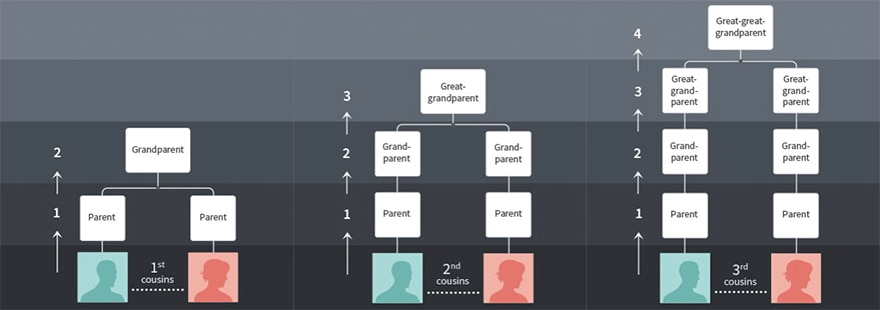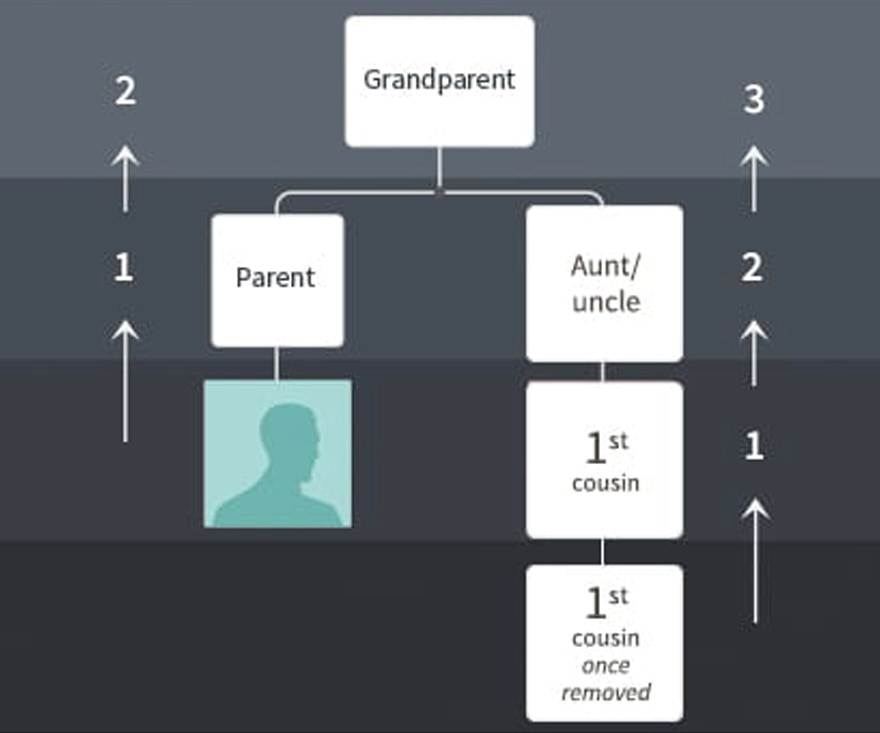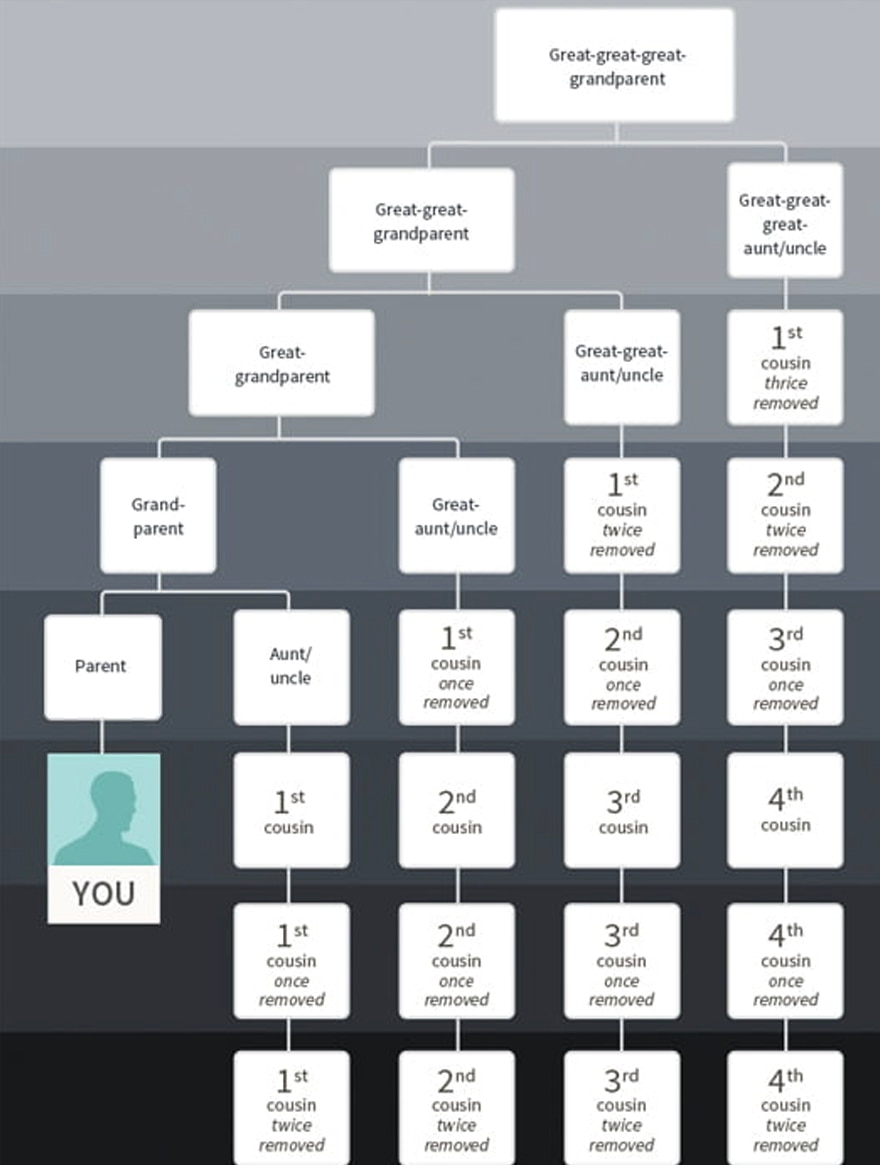Ancestry® Family History
Relatives: Understanding Your Family Connections
One of the most exciting parts of exploring your family story is finding new relatives by building your family tree and finding living relatives (DNA matches) through an AncestryDNA® test. These family connections can add to a richer understanding of who you are and where you come from.
But as your family tree grows, describing all of the relationships can get a bit complex. Luckily there are a couple key concepts that can help you describe how you're related to the various people in your family tree—from second cousins to fourth cousins twice-removed.

Counting Back Generations: Second, Third, and Fourth Cousins
No matter what the cousin relationship you're looking to describe, there are two main components: the number of generations you count back to a common ancestor (second, third, fourth cousins, etc.) and whether or not you and a relative are part of the same generation (once removed, twice removed, etc).
The first component is the number you assign to the cousin relationship. This involves counting back through the generations in your family tree to see how you're connected.
Your parents are one generation back. Your grandparents are two generations back. Your great-grandparents are three generations back, and so forth.

First cousins share grandparents, counting back two generations to their shared ancestors.
Second cousins share great-grandparents, counting back three generations to their shared ancestors.
Third cousins share great-grandparents, counting back four generations to their shared ancestors.
Fourth cousins share great-great-grandparents, counting back five generations to their shared ancestors.
Sensing a pattern? There are a couple quick tricks to figure out your cousin's relationship to you:
Count the number of generations back to your shared ancestors and subtract one. If you count back three generations to your shared ancestor, you are second cousins. If you count back four generations, you are third cousins. If you count back five generations, you are fourth cousins, and so on.
Count the "G"s in the title of your shared ancestors. If you and a cousin share great-grandparents (2 "G"s), you are second cousins. If you and a cousin share great-great-grandparents (3 "G"s), you are third cousins. If you and a cousin share great-great-great grandparents (4 "G"s) you are fourth cousins, and so forth.
Different Generations: Cousins "Once Removed"
The second key component in describing a cousin relationship is determining how many generations you might be apart.
First cousins, second cousins, and so on belong to the same generation as one another; they count back the same number of generations to their shared ancestors.
For instance, you and a second cousin both count back three generations to your shared ancestors: your great-grandparents (your parents, your grandparents, your great-grandparents).
But if your cousin is a generation older or younger than you, the term "removed" cousin must be used.

Imagine that you and a cousin share a relative: it's your grandfather but your cousin's great-grandfather. In other words, you count back two generations to your shared ancestor, but your cousin counts back three generations. In this case, you would be first cousins once removed, since there is a one-generation difference between you.
It's All About the Generations
If you put the two concepts together—counting back the number of generations to a shared ancestor and accounting for any differences in generations—you can put a name to virtually any relation in your family tree.
Each cousin can be numbered based on how many generations back your shared ancestors are and "removed" a given number of times, based on how many generations apart you are from each other.

Top Questions about What to Call Relatives
When it comes to describing relationships, there are a few family connections that bubble up to the top of the many people's lists. Here are a few.
What do I call my father's cousin? Your dad's first cousin is your first cousin once removed. The relatives you and that cousin share are your great-grandparents and their grandparents. When determining if you're first, second, or third cousins (and so forth) you count back the fewest number of generations (in this case counting back two generations to the grandparents, so you're first cousins). And you are one generation apart (you count back three generations to your shared ancestors, and they count back two generations), so you're once removed.
What do I call my dad's uncle? Your father's uncle is your great-uncle, sometimes also called your granduncle. Similarly, your dad's (or mom's) grandfather would be your great-grandfather. For each "great" in the title of one of your parents' ancestors, you add an additional "great" to describe your relationship. Your mom's great-great uncle would be your third great-uncle. Your mom's third great-grandfather would be your fourth great-grandfather, and so on.
What do I call my cousin's cousin? If you're looking at just the side of the family through which you're related, your first cousin's cousins are either your siblings or your own first cousins.
Ready, Set, Connect
Connecting to cousins via Ancestry® can help you collaborate on family history research. You and your relatives all carry different pieces of the family story—and working together you can all create a richer, fuller family story.
AncestryDNA® can help match you with cousins with a high degree of accuracy with a simple DNA test. You could discover many of your 4th and 5th cousins—and sometimes even your 8th or 10th cousins. In fact, if you and your DNA matches have family trees connected to your profiles, AncestryDNA can often find your common ancestors for you and tell you exactly how you're related.
Wherever you are on your family history journey, it's the perfect time to work on finding the stories in your family tree—and now you can describe to your siblings exactly how you're connected to your relative who was part of the civil rights movement or the Revolutionary War ancestor even farther back in your family story.
Already an Ancestry member? Log in now. Not a member yet? Starting a tree on Ancestry is free. Get started now.